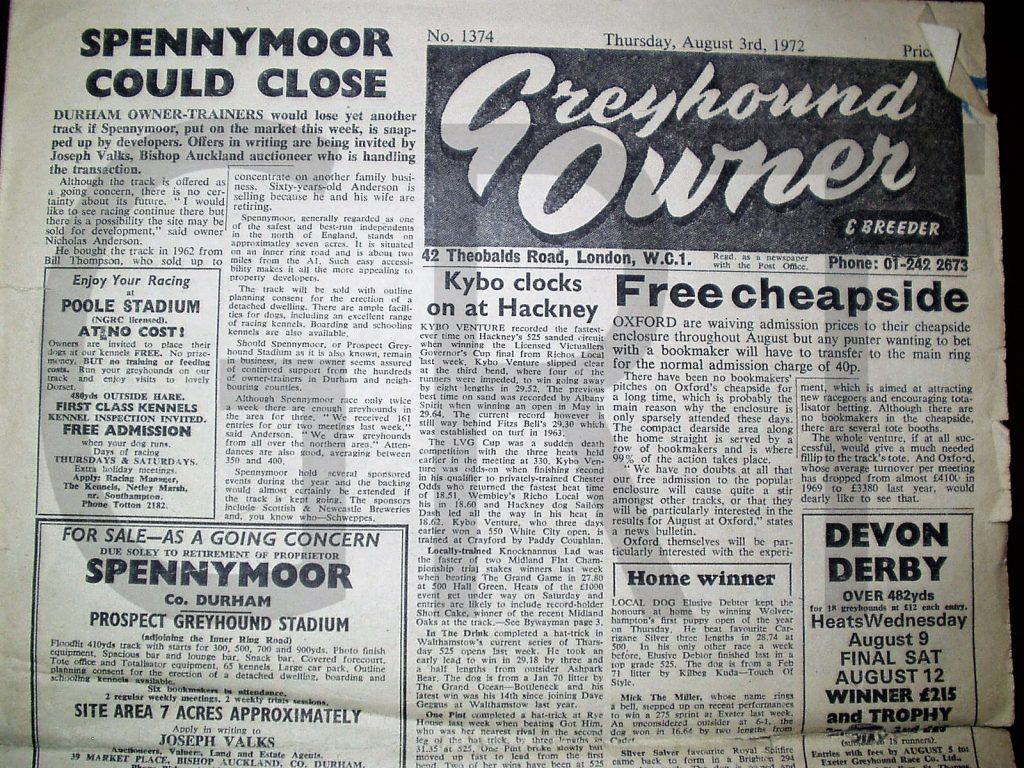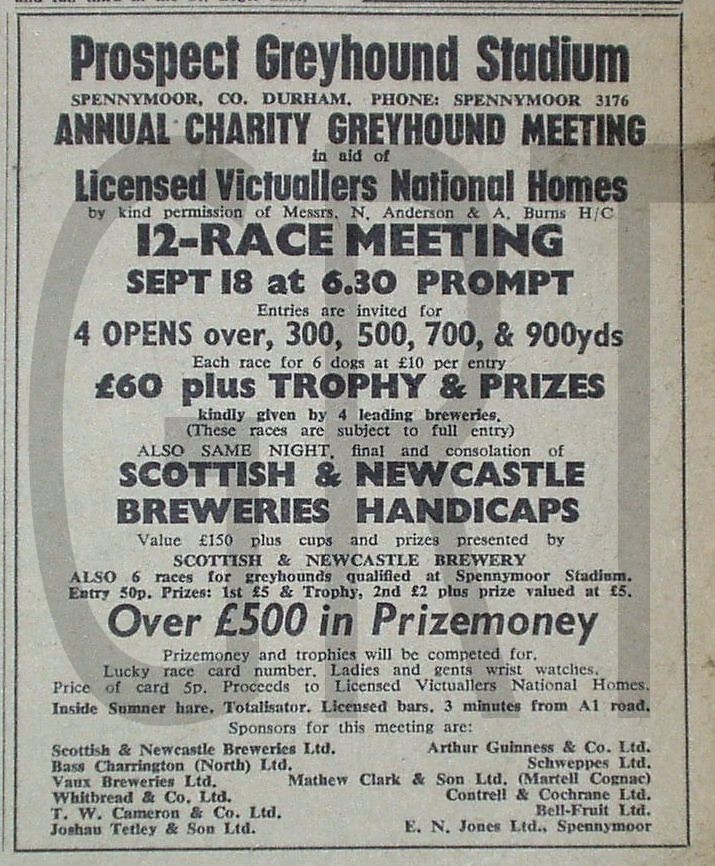Prospect Greyhound Stadium, Front Street, Merrington Lane, Low Spennymoor, County Durham.
POSTCODE———————————-DL16 7RZ
LOCATED————————————On the B6288 Merrington Lane about half a mile south east of Spennymoor town centre, situated behind the Winning Post Public House.
ORIGINAL SITE—————————–Built on the site of an old Brickworks.
DATE CONSTRUCTED——————–1950
DATE VENUE OPENED——————-1950
Meaning other sports may have taken place prior to the arrival of Greyhound Racing.
FIRST MEETING—————————–June 30th 1950.
Greyhound Racing only.
LICENSED OR INDEPENDENT———-Independent then NGRC for the last nine months of existence.
All venues covered would have to be licensed with the government, licensed suggested in this section would refer to tracks operating under NGRC Rules.
INSIDE OR OUTSIDE HARE TYPE——Inside Sumner.
Please note that the Electric Hare suggested is only a guidance and would have been in operation for a certain amount of time at this venue. Although it is not necessarily guaranteed that it was operational all the time, as other types of lure may have been used and updated as time progressed.
DISTANCES———————————-270 and 460 metres.
Please note that most racing venues distances had become varied throughout the years, the ones given above were at once point set and offers only a guidance to the track size.
CIRCUMFERENCE————————–Don’t know.
Please note that alterations at most racing venues throughout its existence would see that the circumference of the track would vary, the one shown above offers only a guidance to the track size.
BIG RACE NAMES————————–Nothing known of.
STADIUM SHARED WITH—————-Nothing known of.
LAST MEETING——————————January 30th 1998.
Greyhound Racing only.
STADIUM CLOSURE DATE—————1998
Meaning other sports may have taken place after Greyhound Racing had ceased.
STADIUM DEMOLITION——————1998-99
BUILT ON SITE——————————Not sure presently, as new housing was planned on site.
In some cases, structure’s that originally covered the venue after the stadium had been demolished, may have been themselves demolished too, so the one described is more likely to be the one which now presently covers the site.
EVIDENCE LEFT TODAY——————If new housing has yet not covered the site, google earth still offers images of were the site once lay.
FURTHER COMMENTS——————-Spennymoor’s reign as an NGRC track of nine months became the shortest membership of any NGRC track since the Second World War.










Another greyhound track to prosper in the north east sector of England, was the one found in the ex coal mining town of Spennymoor in County Durham. Although known as Spennymoor Greyhound Stadium, it had also inherited other titles along the way, such as the Prospect Greyhound Stadium and Merrington Lane, a name more recognised by its regulars.
The stadium lay within half a mile east of Spennymoor town centre, just off the B6288 Merrington Lane, or Front Street as it is known today, situated behind a public house appropriately named The Winning Post. Although this description of its location may sound difficult to find, this wasn’t the case as the track was only a three minute drive away from the nearest exit of the busy A1.
Unlike its neighbouring tracks, Spennymoor arrived during the post war years of the Second World War, having been constructed during the early months of 1950 on a seven acre section of land that had once been the grounds of an old brickworks that closed during the 1920’s. Spennymoor’s first meeting came on the 30th of June 1950, although almost 70 years ago, it seems difficult to accept that it was one of the last independent flapping tracks to open up in the north east. It had a track circumference of 410 yards, which created distances of 300, 500 and 700 yards, and had an inside Sumner electric hare system installed to accommodate six dog racing.
For the next forty years or so, Spennymoor built its reputation as one of the most popular flapping tracks in the north east, but a downward trend during the 1990’s, witnessed the track experiencing some difficult times. During 1996 plans were proposed to turn things around, with an idea to switch to racing under NGRC rules. By spring time 1997 after successful negotiations, Spennymoor was now operating under the new banner, running metric distances of 270 and 460 metres, but within months of the new changes, it was realised that things were not going to plan.
Within weeks of the new years celebrations, concerns were becoming fact, as news unfolded that the tracks owner had gone into liquidation, which in turn lead to an imminent closure of the track on the 30th of January 1998. The last attempt to improve things had failed, as the switch had lasted for just nine months, the shortest period of time that any track had run under the NGRC banner since the Second World War.
After its closure, certain parties began to show interest in reopening the track, but their hopes were soon dashed as a serious blaze, not only destroyed the main stand and clubhouse, but destroyed any chances at all of a swift return to racing. More small fires and continuous vandalism during 1998 and 99 contributed to all remaining buildings being demolished.
The site eventually became nothing more than a dumping ground for local fly tippers, with rubble strewn across a once sanded track that was now losing out to unwelcoming vegetation. After years of silence the site fell into the hands of developers, with newspapers reporting that plans had been submitted to construct more than 200 homes on the site
A photograph or memorabilia for this track is required for this page, if you can help please contact me.

Recent Comments